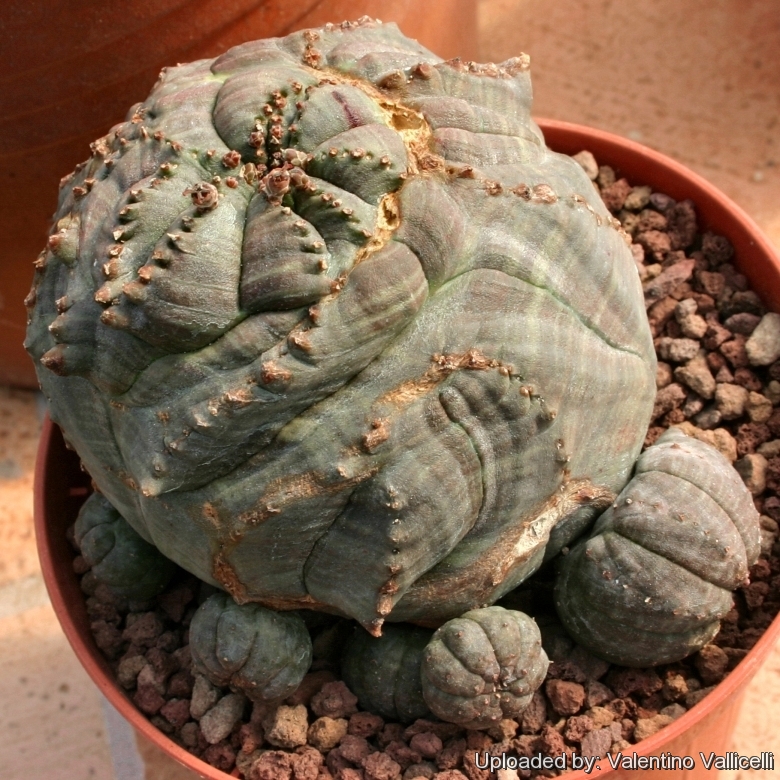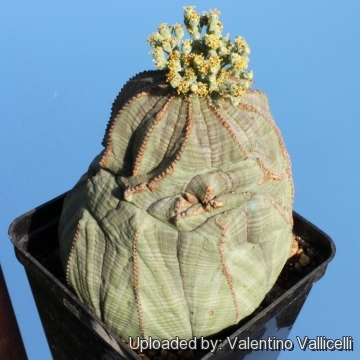
Euphorbia obesa cv. Rocky Mountain Photo by: Valentino Vallicelli
Origin and Habitat: Garden origin (Nursery produced cultivar)
Synonyms:
See all synonyms of Euphorbia obesa
back
Accepted name in llifle Database:Euphorbia obesa Hook.f.Bot. Mag. 129: t. 7888. 1903Synonymy: 3
Accepted name in llifle Database:Euphorbia obesa subs. symmetrica (A.C.White, R.A.Dyer & B.Sloane) G.D.RowleyEuphorbiaceae Study Group Bulletin 11(3): 97 (1998)Synonymy: 2
Cultivars
(2):
back
Description: Euphorbia obesaSN|1966]]SN|1966]] cv. Rocky Mountain is a rare form sought after for its unusual irregular, broken or branched ribs, that looks like an old weathered rock. In all other characteristics, namely size and shape of stems, flowers, fruits, roots etc. it is very similar to the standard species. Every plant is different and particular, and the form and shape of ribs varies with time.
Habit: It is a spineless succulent plant, usually solitary, but will sometimes 'branch' or sucker, creating very odd looking clusters of spheres.
Root: Tapering tap root.
Stem: Solid, firm, dome shaped, spherical, or when old twice as high and elongated or cone shaped, up to 20(-30) cm in height with a diameter of 9-10 cm, grey green, iron-grey, bluish-green or brown-green with very attractive transverse red-brown or dull purplish bands and with finely marked longitudinal seams marking its surface, creating an almost plaid effect. The younger plants have a rounded sea urchin-like shape and are very similar to the common Euphorbia obesa, but the epidermis of this cultivars starts soon to split open assuming the appearance of a rock surface and in a few years the plant take on a completely different appearance. The stem slowly grows up to 20 cm in height, 10 cm in diameter.
Ribs: Usually vertical, broad, slightly raised with shallow furrows in between, but ribs tend to become irregular, broken or branched.
Leaves: The leaves are very rudimentary, minuscule and soon drop off
Flowers: This Euphorbia is unisexual with the small, greyish green cyathia normally being all male on some plants, or all female on others. Therefore cross pollination between a male and a female plant is required to produce seeds. Pollination usually carried out by insects. All euphorbias have a complex floral arrangement that is termed a cyathium (a cup) and this is the unit of the inflorescence. A cyathium contains many highly reduced male flowers or a single female flower. In Euphorbia obesaSN|1966]]SN|1966]], the cyathia appear in summer, from "circular flowering eyes", situated along the tops of the angles, near the growing tip, on the stem. They are produced on fork-branched peduncles (flower stalks), have minute bracts and are finely hairy. The cyathia are cup-shaped to 3 mm in diameter, expanding in the female.The tiny flowers are delicately scented
Fruits: The fruit is a slightly 3-angled capsule , up to 7 mm in diameter that explosively releases the seeds. The peduncles do not persist, and fall off after the seed has been dispersed.
Seeds: Small rounded 2mm diameter mottled grey when mature.
Subspecies, varieties, forms and cultivars of plants belonging to the Euphorbia obesa group
 Euphorbia obesa cv. Rocky Mountain Photo by: Valentino Vallicelli
Euphorbia obesa cv. Rocky Mountain Photo by: Valentino VallicelliSend a photo of this plant.The gallery now contains thousands of pictures, however it is possible to do even more. We are, of course, seeking photos of species not yet shown in the gallery but not only that, we are also looking for better pictures than those already present.
Read More... Cultivation and Propagation: It likes a sunny position, but it can also be grown outdoors where the frost is not too severe. It can tolerate temperatures down to -5°C (-10° if the roots are kept dry). It does best in a mineral soil, but is tolerant of a wide range of soil types. Good drainage is essential. Water sparingly during the summer months and keep dry in winter. It is a slow-growing, long-lived plant, and once established, it will be content in its position and with its soil for years. It can tolerate moderate shade, and a plant that has been growing in shade should be slowly hardened off before placing it in full sun, as the plant will be severely scorched if moved too suddenly from shade into sun.
Propagation: It is propagated from seed sown during spring or summer. Germination occurs within 3 weeks, but it can be reproduced by cuttings as well (if available). Flowering can be achieved within 5-8 years.
Warning: As with all other Euphorbias, when a plant get damaged it exudes a thick white milky sap known as latex. This latex is poisonous and may irritate skin.











